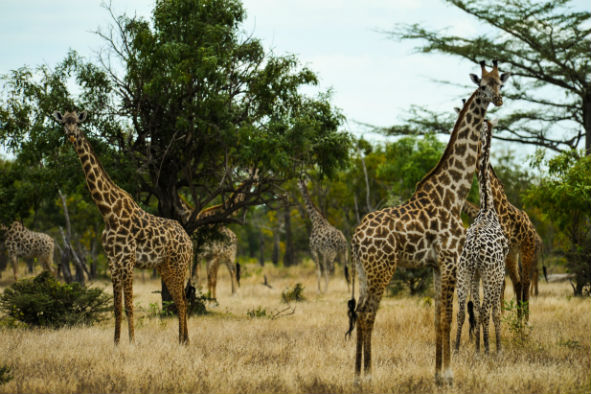Situated in southern Tanzania, the Selous Game Reserve is a prime destination for game spotting. Far from the maddening crowds of the north, the Selous offers an intimate safari experience, where the wildlife is plentiful but the traffic is scarce.

Photo: Oli Anderson
The first thing that might strike you about the Selous is the light. The same could be said for many drifts of Africa, but here, in the late afternoon, it’s as though the heavens have grown swollen with metal and showered the plains with molten gold. Guinea grass flutters in the shadows of immense baobabs, trees cast with platinum as the last rays of sun linger on their wide boughs. The skies, painted with rosy clouds as abstract as a drunken brushstroke, pale against the indigo of the shadowed bush.
The Selous Game Reserve is located deep in southern Tanzania, far from the growling tourist-filled jeeps of the north and its Ngorongoro Crater. Acknowledging the variety of animals inhabiting the park, the Selous was designated a World Heritage Site in 1982 and remains an untouched expanse of nature, spread over a huge expanse and undisturbed by man. It’s endless plains split by the Rufiji River, the park is a sea of vast, dry bushland, with pockets of verdant Miombo woodland and riverine forest lush as any jungle.
In the dry season, the river is barely a trickle of brown mud amidst an empty, cracked bed; the forests grow tired and bare. Nevertheless, the dry season, which runs June through October, is often cited as the best time to visit; the temperature drops slightly and the animals congregate around fewer water sources, meaning guaranteed sightings. When the rains come, they wash away the bumpy jeep tracks and course through the bush, soaking into the ground and filling the trees with leaves and budding flowers. October through May is green and quiet, as well as being the best time for bird watching.
Game drives here are exhilarating in so much as you simply don’t know what you’ll see. Given the enormity of the park and the fewer tourists, the animals are less familiar with humans and resultantly suspicious of jeeps; meaning encounters are brief but heart pounding.

Photo: Oli Anderson
This park is special for several reasons. Home to Africa’s largest populations of elephant and wild dog, it’s inhabited by a huge number of game, which makes walking safaris and fly camping a real treat. Some of the truly rare species can be found in large numbers here, from black rhino to leopard. With the river and lakes providing an oasis for wildlife, it also makes for some of the best boat safaris in the world.
We’re up before dawn, sipping hot coffee and piling into a jeep, bundled in fleece. Along the way, countless delicate impala flit through the bush, pausing to turn their beautiful faces toward us before dancing away in synchronicity. It takes time for our eyes to adjust to the slightest movement; a distant tree becomes the neck of a giraffe, ears flitting like leaves in the wind, a dense boulder snorts, suddenly a hippopotamus. A lioness flexes her muscles beneath a coast of sand, tiny cubs wriggling at her side. A young and noisy bull elephant asserts his authority by flapping overly large ears and mock-charging. Patchwork giraffes eye us steadily before galloping off, an optical illusion of slow motion as they pound their hooves into the turf.
While the Selous is still very much untouched, there are still a few lodges to pick from, though most are fairly expensive. There’s the gorgeous Azura Selous, a collection of just 12 designer tents with private plunge pools set along the Ruaha river and a resident elephant. Similarly luxurious, there’s the longstanding Beho Beho or Sand Rivers with its world-renowned guides, or riverside Selous Safari camp. Less expensive is Lake Manze, situated on an elephant highway or Rufiji River camp. For something a little less game-focused, there’s The Retreat.

Tented Villas at Azura Selous
Most camps are accessed by light aircraft, an hour or so from international airport and capital of the country, Dar es Salaam. Every one offers sensational game drives, walking safaris, river trips and fishing. Some offer starlit sleep out experiences in the bush for those wishing to get out from under the tent.
But we settle for watching the stars from our dinner table, extinguishing the oil lamp and letting our eyes adapt to the darkness, the sounds of the African night carrying over the plains. The stars are so bright, so hypnotic; I can barely tear my eyes away. Every half second, one streaks across the darkness and vanishes forever from our skies.
“Thousands of years ago,” our guide Isaiah tells us, “when the moon was young and round, a tribesman fell in love with her. But each night, she grew thinner, further away, fading. He spoke to her, sung to her, but still she waned.”
‘One night, he set out, searching for light to help her regain strength. He collected handfuls of fireflies and cast them above his head, where they rose, glowing. The next night, the tribesman saw that the moon had grown stronger, so he asked the fireflies to stay and watch over her.”
‘And there they stayed, so that when the moon is weak, the sky remains lit until she is strong again.” Far above us, unimaginable science breathes galaxies and constellations across the sky, rolled out like a glowing map to the heavens.